Three takes following SDSU’s victory over UNLV
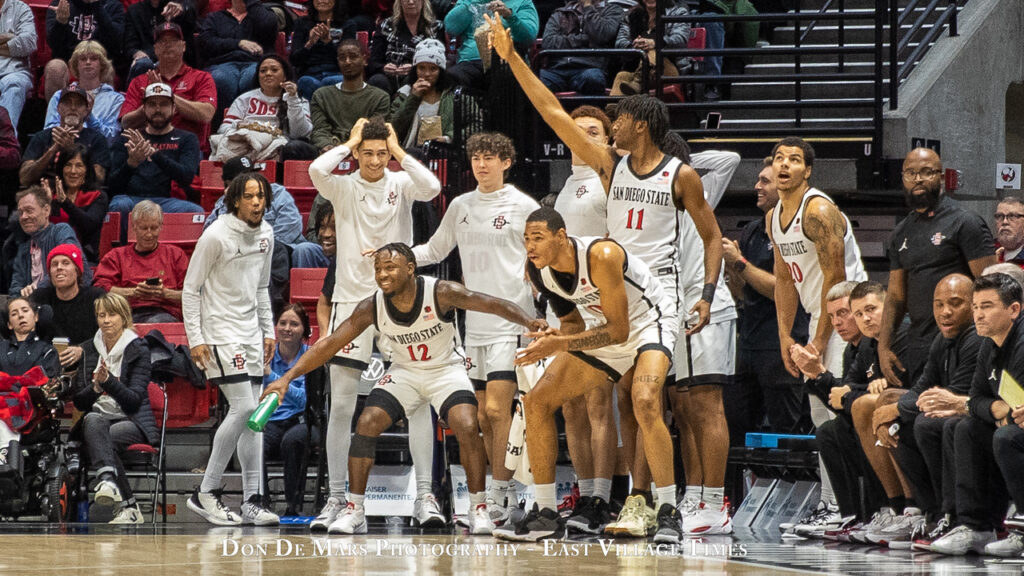
(Don De Mars/EVT)
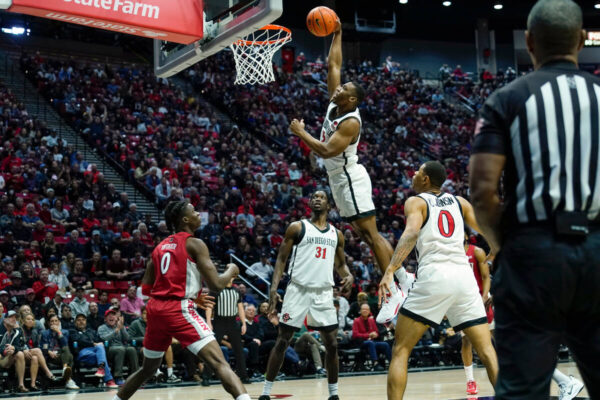
About forty-five minutes before the game, at the basket in front of the Show, SDSU’s frontcourt ran through a series of drills designed to replicate the skills they use inside the Aztecs’ offense. During one rep, Nathan Mensah, Jaedon LeDee, and company set screens on imaginary defenders at the top of the key for the program’s student managers, who were mimicking SDSU’s backcourt. After, they rolled to the basket as the managers lobbed passes for ally-oop dunks.
In the next sequence, the lob was not delivered, and the players moved into the post for hook shots. With JD Pollock supervising at half court, each subsequent drill built off the previous one until the frontcourt had practiced the majority of the techniques they put into practice during the game.
On most nights, fans who arrive early will witness SDSU’s bigs rehearsing dribble handoffs or ball screens in a motion offense. For the Rebels on Saturday, they mixed it up.
“Whatever actions we do in the game, we warm up before the game just to have that comfort level that you know what you’re doing,” SDSU head coach Brian Dutcher explained postgame. “Everyone plays you differently. We run a lot of ball screen motion, handoffs (most games). We didn’t run as many today because they switch a lot of that. I just didn’t think we needed to do that. We tried to run more mid-ball screens and had more success with that.”
The expert coaching paid off immediately on Saturday afternoon. On SDSU’s opening basket, Mensah set a screen for Lamont Butler. UNLV did not fully switch, and Mensah cut to the basket, caught a chest pass, turned, and dunked the ball. After forcing a shot clock violation on the Rebels’ first possession, Butler found Keshad Johnson for an alley-oop. Both sequences were similar to what Dutcher and his staff emphasized before the contest.
Another subtlety of the pregame ritual was the intentionality that Johnson and Aguek Arop practiced with. On one occasion, as Johnson received the ball on one side of the court, the order went out to switch sides. Instead of finishing his turn, throwing up a meaningless shot, or delaying the drill in another way, Johnson crisply passed it to the other side and sprinted to the back of the line.
When the student manager lobbed a pass to Arop instead of bouncing it into the post like he was supposed to, AG flicked the ball back outside, sprinted to the front of the line, and did the drill correctly. By their actions, they made sure the pace of the practice was crisp and businesslike. The Aztecs were there to put in work, nothing more.
The intangible impact of Johnson and AG’s approach will be felt in the coming years as they pass the baton to the next group of frontcourt players. Demarshay Johnson and Elijah Saunders followed the veterans in each drill. As the sequences went on, they matched their older teammates’ intensity, focus, and pace. The younger athletes participated in a lab, a master class taught by their peers. They experienced what professional-level work is like.
SDSU’s Size Advantage
SDSU’s size advantage was apparent from the opening tip. UNLV did not start a player taller than 6-foot-7. The Aztecs bullied the Rebels into a quick lineup and strategy change. SDSU’s first eight points came from inside, forcing UNLV to bring in bigger players. 6-foot-7 Victor Iwuakor left the game in favor of 6-foot-10 David Muoka, and 6-foot-4 guard Elijah Parquet replaced 6-foot Jordan McCabe.
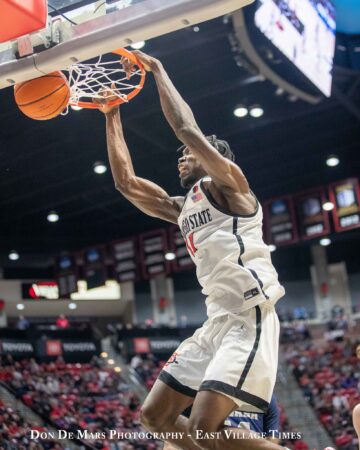
“First of all, the guys in the paint, we try to make the game easier on ourselves by getting closer to the basket…,” Mensah said postgame. “Anytime we get rolling, that’s when the guys on the perimeter get open also, just like today. It got to the point where they started helping on the backside, so Adam (Seiko) was open. It was to the point where they were slacking off Lamont, Keshad, and all those guys. Anytime we go and shine out, it transforms the team in a different way.”
Exactly what Mensah explained took place on the court. UNLV had to help inside, and it opened up more space outside for shooters than what the Aztecs are accustomed to seeing. In opening up a 20-point halftime advantage, more than half of SDSU’s shots came from behind the arc. With a few exceptions, all of them were good looks.
UNLV adjusted its tactics at the 16:22 mark with the score 8-6. Over the next two and half minutes, SDSU spurted ahead 22-11 with Johnson, Matt Bradley, Seiko, and Micah Parrish all hitting three-pointers. What the Rebels found out early is what the rest of the conference is slowly learning. The Aztecs are growing into a balanced offense, forcing the opposition to pick their poison.
“A couple of games ago, I’m not sure which one, we made an emphasis to feed them,” Bradley explained after the game. “They work so hard down low on the defensive end, rebounding, and when we’re able to play inside-out, it causes more opportunities for us as guards and for them down low. You’re definitely like a dual-threat team when you do that. They’re really good down low. Jaedon, Nate, AG, Keshad, so we’ve got to utilize them more, and I think we’ve been making that an emphasis.”
The results speak for themselves. On the 14-5 run described above, SDSU had three assists on five made baskets. Arop and LeDee had two of them. It set the tone for the game. The Aztecs assisted on 23 of their 31 made field goals.
Inbounds plays
SDSU has had trouble keeping second-half leads. Utah State on Wednesday is the most recent example. Aside from some sloppy play late that allowed UNLV to make the game appear closer than it was, the Rebels’ comeback attempt was thwarted in large part because SDSU was terrific on inbounds sets along the baseline.
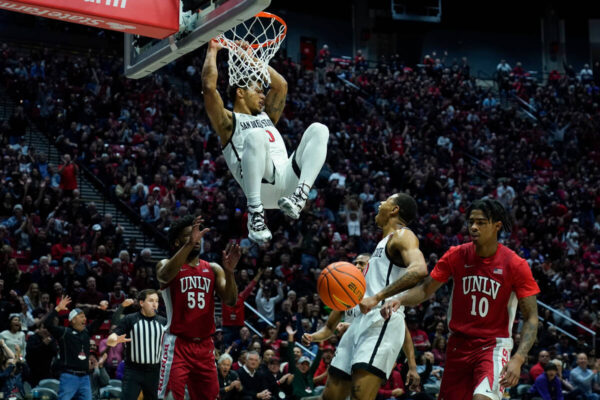
After falling behind by 20, UNLV’s best chance to make the outcome in doubt came within the first four-plus minutes of the second half. The Rebels found some offensive rhythm, scoring 10 points on three of four shooting while getting to the line five times and converting four. Defensively, they stifled the Aztecs in the half-court and forced multiple turnovers. The closest they were able to get, however, was only within 14 because of SDSU’s skill in their designed plays.
“We were elite at baseline out of bounds,” Dutcher said matter of factly. “They switch screens, so when you curl a guy around, sometimes it’s hard to find that guy when you’re switching. They don’t know when to switch. We curled Micah around twice and got layups. We got Adam a three on the same play where they took the curl around away, and Adam ran the second option on the play and got the three. The third option, sometimes we get a slip for a dunk if they switch out.”
“We did a good job, and then, I drew up a play out of a timeout where I ran a rear screen for Nate, for Matt to throw a lob to him. We got a foul on that. … We did a good job on baseline out of bounds both offensive and defensively.”
Without the precision on those plays early in the second half, UNLV’s run may have continued. The plays only counted as four points in the box score, but they meant much more in the scheme of the game. Not only did they prevent the Rebels from stringing together a longer run, but the feel that the Aztecs were in control of the contest never left.
Quick Takes:
– At the next level, Lamont Butler is going to be a triple-double threat. He finished Saturday with seven points, seven assists, and seven rebounds. His impact on the game goes beyond statistics. He is one of the unique players who you have to see in person to understand his impact. When he is at his best, the game orbits around him on both sides of the court.
– The intelligence of the Viejas Arena crowd was evident in the speed at which thousands of people simultaneously reacted to the smallest infraction missed by the referees. It is one thing for a crowd to support a head coach arguing a call, but it is another to hear a chorus of exclamations when an opponent slides his pivot foot.
– The National Anthem was outstanding on Saturday afternoon. Victor Morris, who has graced Viejas Arena before, brought the house down.
– Keshad Johnson’s start to the game was terrific. When he is playing with a high motor and making shots, he is unguardable by anyone in the Mountain West. The ceiling of 2022-2023 Aztecs is tied to Johnson’s ceiling. There have been stretches over the past few weeks where Johnson has looked like a legit NBA prospect. Saturday’s opening 10 minutes was one of those occasions.
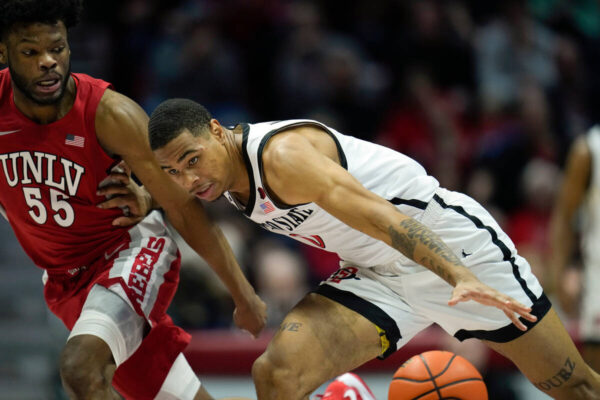
– UNLV’s EJ Harkless had a Swaggy P moment early in the game. Off a steal, Harkless found Luis Rodriguez for an open look. Harkless turned his back to the basket and extended his arms. It was a great look, but Rodriguez missed.
– One of the improvements in the offense is Bradley is waiting until the end of the shot clock to work in isolation. It is a smart tactic. Bradley is a difficult shot-maker. He can create those looks at any point. It makes sense to work the ball around and run some offense first instead of hunting that shot early.
– In the first half, following a pair of made free throws, SDSU chose to press for the first time in the game. Dutcher walked nearly to half-court to tell Bradley to be further up in the press away from the basket. Before anyone else in the gym realized what was happening, Dutcher saw the trap in the backcourt and arched his back, knowing that Bradley should intercept the subsequent pass. When he did, Dutcher confidently walked back to where he was supposed to be with a skip in his step.
– Bradley finished the play with a dunk, prompting UNLV to call a timeout to stop the 14-0 run. SDSU’s bench exploded towards the players, and Dutcher sprinted to head them off, yelling, “get back.” The lessons of Utah State were put into practice.
– Among the many skills Bradley has improved on during his two years on the Mesa is rebounding. He is terrific at tracking down and rising to gather attempts above the bigger players on the court.
[wpedon id=”49075″ align=”right”]
– The Show had one memorable moment. They belted out the Backstreet Boys I Want It That Way like a choir.
– Both sides coached until the end. Dutcher said postgame he put his starters back in the game because a 12-point lead under a minute is still a game. UNLV head coach Kevin Kruger agreed. He used a timeout with 46 seconds remaining.
My earliest sport’s memory involve tailgating at the Murph, running down the circular exit ramps, and seeing the Padres, Chargers and Aztecs play. As a second generation Aztec, I am passionate about all things SDSU. Other interests include raising my four children, being a great husband and teaching high school.